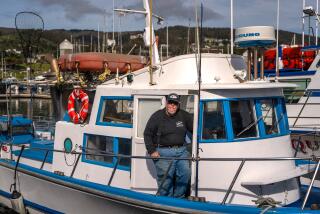River of plenty: Oregon projects huge salmon run for the troubled Klamath River
Talk to a fisherman on the West Coast and he’ll give you a hard-luck story. The once-glorious salmon runs of the Pacific Northwest are mostly shadows of what they once were, some threatened with outright extinction, and few rivers have had as many troubles as the Klamath, as it runs from southern Oregon into Northern California.
Once the third-most productive salmon river system in the U.S., the Klamath last year saw only about 233,000 fall chinook — the big, meaty salmon prized by fishermen — headed back to spawn. In 2008, the number was only 68,000.
That’s why it was stunning news Tuesday in Newport, Ore., when the Oregon Department of Fish and Wildlife presented its annual forecast for the Klamath’s fall chinook run. Nearly 1.6 million fish are expected to be in this year’s run, a figure that’s nearly triple anything on the charts that go back to 1996.
The monster run, if it plays out as predicted, could provide a welcome bonanza for the troubled commercial fishing industry in California and Oregon and for the dozens of communities along the river that host sport fishermen when there’s anything in the river to catch. Conservationists say it also vindicates years of efforts to maintain healthy water flows and better habitat for fish that have battled both drought and hydropower dams for decades.
A strong fall chinook run is also forecast for the Sacramento River, which could see four times the number of fish compared with 2011, or a total of 819,400 fish.
“Both of those numbers look pretty good,” Steve Williams, deputy administrator of Oregon Fish and Wildlife’s fish division, told the Los Angeles Times after presenting the figures in Newport. “They obviously are evidence of good ocean survival conditions that have allowed those fish to thrive and become available this year, potentially some of them, for harvest.”
Environmental groups have been working for years to improve fish habitat on the Klamath by fighting efforts to draw out water in the Upper Klamath Basin for irrigation. They are on the verge of getting federal approval to remove four hydropower dams that have been a major impediment to fish health.
In 2002, diversion of water to agriculture cascaded into other problems that led to the die-off downstream of at least 34,000 fall chinook — probably twice that number — one of the biggest fish kills in Northwest history.
“There’s been too much water promised to too many people, and there’s been lots of fights,” said Kristen Boyles, an attorney for Earthjustice in Seattle, who has joined the legal effort to keep more water in the river.
But tribes along the river have worked steadily to protect fish habitat, other stakeholders have negotiated water usage issues and possible removal of dams, and last spring there was abundant rainfall, guaranteeing sufficient water for migrating juvenile fish even without court fights.
State fish managers and fishing industry advocates say good ocean conditions too — abundant food and fewer predators — would have to have played a role in so robust a predicted run.
“Nothing dramatic to my knowledge has changed in the Lower Klamath, but most likely since we’re seeing tremendous response from coho [salmon] as well along the Oregon coast, that indicates to me that a lot of the improvement is due to survival in ocean conditions along Northern California and throughout Oregon,” Williams said.
Healthy stream flows in the Klamath “could easily be a factor,” he added.
David Bitts, president of the Pacific Coast Federation of Fishermen’s Associations, said the highest fall chinook return he could remember in the Klamath was perhaps 60,000 in about 1980.
“So yeah, it’s just really good news,” he said. “Some years ago when something like this happened, a friend of mine said, well, maybe it means we haven’t screwed it up too bad yet.”
The forecast is so large, he added, that the river may not be able to sustain that many fish without crashing the 2013 population. He will argue, not surprisingly, for a big catch quota when the Pacific Fishery Management Council structures this year’s fishing season in April — the reason all the fish forecasts were developed to begin with.
For once, everyone seems to agree, it’s good to be able to worry about having too many fish.
“These numbers are fantastic,” Boyles said. “We’re always fighting a picture that is environmental protection versus jobs. But that is a fake, a veneer put on a much bigger problem, which is how do you have the resources to have the salmon and the jobs and the economic activity in places where we all want to live?”
ALSO:
Klamath River cleanup wins federal approval
Dam removal begins, and soon the fish will flow
Removal of 4 Klamath dams would boost salmon populations, studies find
More to Read
Start your day right
Sign up for Essential California for news, features and recommendations from the L.A. Times and beyond in your inbox six days a week.
You may occasionally receive promotional content from the Los Angeles Times.






